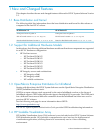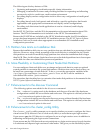The following are the key features of SVA:
• Capturing and managing visualization-specific cluster information
• Managing visualization resources and providing facilities for requesting and allocating
resources for a job in a multi-user, multi-session environment
• Providing display surface configuration tools to allow easy configuration of multi-panel
displays
• Providing launch tools, both generic and tailored to a specific application, that launch
applications with appropriate environments and display surface configurations
• Providing tools that extend serial applications to run in a clustered, multi-display
environment
See the HP XC QuickSpecs and the SVA documentation set for more information about SVA
features. The SVA documentation set is included on the HP XC Documentation CD.
Because the SVA RPMs are included on the HP XC distribution media, the SVA installation
process has been integrated with the HP XC installation process. The HP XC System Software
Installation Guide was revised where appropriate to accommodate SVA installation and
configuration procedures.
1.5 Partition Size Limits on Installation Disk
Because the installation disk size can vary, partition sizes are calculated as a percentage of total
disk size. However, using a fixed percentage of the total disk size to calculate the size of each
disk partition can result in needlessly large partition sizes when the installation disk is larger
than 36 GB. Thus, for this release, limits have been set on the default partition sizes to leave space
on the disk for other user-defined file systems and partitions.
1.6 More Flexibility in Customizing Client Node Disk Partitions
You can configure client node disks on a per-image and per-node basis to create an optional
scratch partition to maximize file system performance. Partition sizes can be fixed or they can
be based on a percentage of total disk size. To do so, you set the appropriate variables in the
/opt/hptc/systemimager/etc/make_partitions.sh file or set the variables in
user-defined files with a .part extension.
The procedure that describes how to customize client node disk partitions is documented in the
HP XC System Software Installation Guide.
1.7 Enhancements to the discover Command
. The following options were added to the discover command:
• The --nodesonly option reads in the database and discover all nodes if the hardware
configuration contains HP server blades and enclosures. This option is valid only when the
--enclosurebased option is also used
• The --nothreads option runs the node discovery process without threads if the hardware
configuration contains HP server blades and enclosures. This option is valid only when the
--enclosurebased option is also used.
1.8 Enhancements to the cluster_config Utility
The cluster_config utility prompts you to specify whether you want to configure the Linux
virtual server (LVS) director to act as a real server, that is, a node that accepts login sessions.
If you answer yes, the LVS director is configured to act as a login session server in addition to
arbitrating and dispersing the login session connections.
If you answer no, the LVS director does not participate as a login session server; its only function
is to arbitrate and disperse login sessions to other nodes. This gives you the flexibility to place
16 New and Changed Features


















